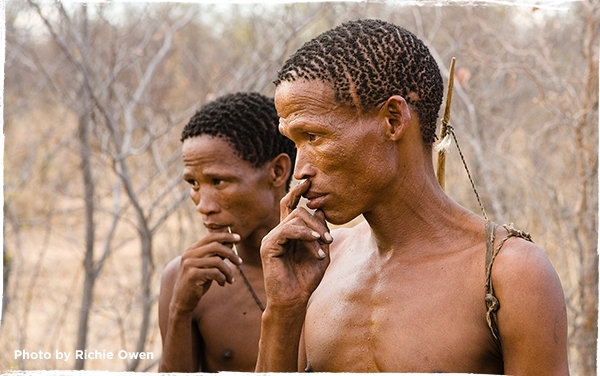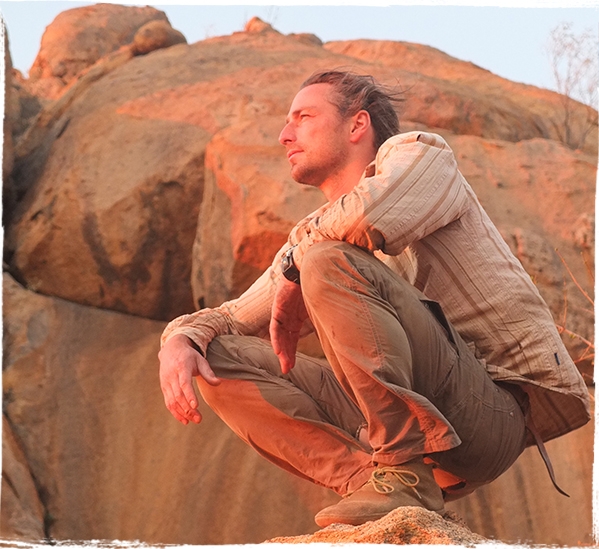It was a perfect African evening; I was sat round the glowing embers of a fire, enjoying the warm breeze, a cold beer, and the company of friends. I had ‘gone bush’ with my partner Lisa, my buddy Werner and two San Bushmen. It had been a long, hot, dusty day of exploring the velt, tracking animals and learning about the San’s bushcraft skills. The conversation had fallen away to a comfortable lull when it was suddenly punctuated by a loud owl hoot. /Ao, the hunter, whispered something to his friend, Amasche, and I asked what he had just said. /Ao explained that the owl was saying that there is an Eland under its tree. Werner grinned and shook his head, saying that it was impossible, there were no Eland in this area. /Ao laughed quietly to himself and conversation soon rekindled with plans for the following day.


The next morning we investigated the mystery owl hoot, wandering through the bush, scanning for tracks. Suddenly we heard Werner‘s cry of surprise as he pointed to a perfect Eland track under a big tree. Eland tracks are unmistakable, as the outer cleat of the hoof is considerably bigger than the inner one, with a pronounced overlap at the tip (as a result they make a unique clicking sound as they walk). /Ao just smiled when we asked him how he had known last night. He simply said that the owl had told him; he added that the owl has different calls for other animals and birds too… even calls that distinguished between different species of snake. He told us that there are other animals who can also talk, such as the baboon, the jackal and the rock dassie. We were all astounded. He went on to apologise that he was not very good at this lost language! He said that his father, and his grandfather knew a lot more of the calls, but when they had died this deep ancestral knowledge of animal and bird language had all but disappeared. /Ao is the last of the wild Bushmen, he didn’t even see a ‘white man’ until he was fourteen, as he lived in the remote velt with his family. It was only with the encroachment of the South African military into his world, when he was forced to join the army as a tracker, that he saw his first Westerner. He now lives with his family in an established village the bush, but he still hunts traditionally, and teaches his children, and the other young people of the village the ancient wisdom that he treasures.


Derived from the Tswana word Kgalagadi, meaning "a waterless place", the Kalahari is a vast semi-arid scrub savannah, spanning Eastern Namibia and Western Botswana. It is a land of extremes, from the brittle frosts of winter, to the burning sun and oppressive heat of summer, which turns the land into a barren, tawny sweep of scorched grass-covered dunes. The dunes seem to roll ever onward, spanning a staggering 350,000 square miles. The silhouette of a giant Baobab tree occasionally breaks up the landscape as it reaches its giant finger-like branches up two hundred feet above the red Kalahari sands. The occasional heat-haze rises from the horizonless, shimmering saltpan. Despite being a harsh land, it is easy to fall in love with the Kalahari and be bewitched by its brooding tawny landscapes and gentle people. The San Bushmen know this land well, as their ancestors have lived in the Kalahari Desert for the last 160,000 years.
For the San, the Stone Age ended sometime during the 1600’s with the arrival of the ‘Whites’ and the first colonies to settle in the Cape. However, one of the earliest San artifacts on record is a set of hunting weapons and tools dating to 44,000 BC. It is identical to those used by the modern San for hunting today. Although today’s San have been forced to live in sedentary villages, there are certain areas where they are still allowed to hunt traditionally.


Masters of desert survival, the San Bushmen’s hunting tactics vary according to their quarry, the time of year and even the time of day. They are famed for their almost supernatural tracking ability. Their main method of hunting is to track an animal, shoot it at close range with a poison arrow, and then track it until it succumbs to the poison. Their other, potentially older form of hunting is a rapidly vanishing skill – the legendary persistence hunt – thought to be one of our ancestral survival strategies, which have actually shaped our bodies into how we look today. Combining our uniquely human ability to visually follow tracks, whilst speculating the future, with our ability to run for long distances, gives us the ability to persistence hunt - a wonder of evolutionary biology. There are a few remaining San Bushmen who still have the skill and endurance to run down large antelope in the midday heat, covering distances in surplus of twenty miles on hot sand, in temperatures over 40°C, relentlessly tracking and pursuing the animal until it can’t run any further. The Bushmen believe that the animal accepts its death and gives itself up. It is killed cleanly with a spear thrust through the heart, and treated with much reverence and respect for its gift of life. The Bushmen are so deeply connected with the natural world that they see themselves as part of nature, not apart from it. I have visited the San many times over the last ten years. My experiences and memories are some of the richest ones I hold. Their grace, humility and generosity never cease to amaze me. They have a lot to teach us…. if only we will listen.
- Ben McNutt



